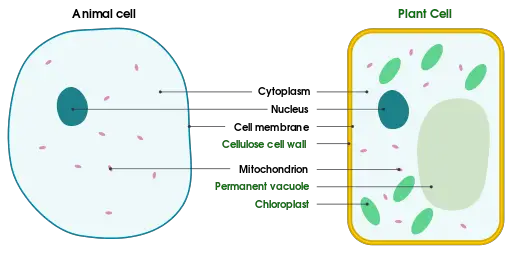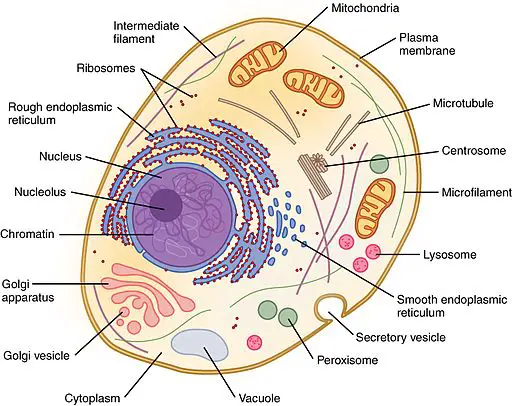Differences between Cytosol and Cytoplasm
Overview
Cytoplasm and cytosol are both part of the protoplasm. While the cytoplasm includes everything within the cell membrane (with the exception of nucleus and its contents), cytosol is the fluid within the cell in which organelles and other materials float.
* The cytosol is part of the cytoplasm.
Cytosol
As mentioned, the cytosol is the fluid part of the cytoplasm in which cell organelles and other components are embedded. Within the cell, the cytosol is enclosed by the cell membrane. In addition, it can be found within various membrane-bound organelles (e.g. within vesicles, vacuoles, chloroplast, etc.) in eukaryotic cells.
Cytosol Components
In human cells, the cytosol takes up about 70 percent of the total cell volume. While water is the primary component of this fluid, making up about 70 percent of the total volume, it also consists of a number of other components that include proteins (less than 300 Da in size and range from 20 to 30 percent of the total cytosol volume) and ions (calcium, sodium, magnesium, and chloride ions, etc.) among other hydrophilic molecules.
Due to the presence of these dissolved molecules and ions, the cytosol has the consistency of jelly rather than a liquid. The concentration of these molecules and ions in the cytosol serves a number of functions including regulating the movement of water in and out of the cell as well as promoting cell communication etc.
* The cytosolic pH value ranges between 7.0 and 7.4.
* Some of the other materials that can be found in the cytosol include cytoplasmic bodies, crystalline inclusions, stress granules, and cytoplasmic inclusions, etc.
Functions
The cytosol is involved in a number of functions that are essential for the proper functioning of cells.
These include:
Structural support - Depending on the type of cell, the cytosol can take up to 70% of the total cell volume. This volume contributes to the overall shape of the cell. Depending on the concentration of molecules and ions in the cytosol (and outside the cell) water can move in or out of the cell through osmosis. In plant cells, for instance, turgor pressure, also known as hydrostatic pressure provides structural integrity to each cell and the tissue in general.
Hydrostatic pressure is essential for various processes such as the opening and closing of the stomata. In both plant and animal cells, the cytosol also creates room and promotes the movement of various materials from one organelle to another and from the cell membrane to the organelles and vice versa.
Signal transduction/cell-to-cell communication - Cell to cell communication is essential for the proper functioning of various tissues and organ systems. Here, various molecules and ions, etc. dissolved in the cytosol play an important role in these functions.
For instance, during synaptic transmission, neurotransmitters packaged within vesicles within the cytosol are transported to the presynaptic membrane in order to be released into the synaptic cleft before reaching the postsynaptic membrane. At the postsynaptic membrane, neurotransmitters come in contact with specific receptors thus influencing a specific action.
In this case, the cytosol allows for the movement of neurotransmitter vesicles to the cell surface (postsynaptic membrane) so that they can fuse with the membrane and release their contents, neurotransmitters, to the synaptic cleft.
Once they activate the postsynaptic neuron, neurotransmitters may be taken up by the presynaptic neuron to be repackaged in vesicles and stored in the cytosol before the process repeats.
Transport of metabolites - Within the cell, metabolites are transported from their site of production to the target destination through the cytosol.
* In prokaryotes (organisms that lack membrane-bound organelles), various biological processes and reactions take place in the cytosol.
* The cytosol is also known as the intracellular fluid (ICF).
Cytoplasm
The cytoplasm consists of three main components.
These include:
· Cytosol (discussed above)
· Cytoplasmic organelles
· Inclusions
* The cytoplasm is usually described as anything between the nucleus and the cell membrane in eukaryotic cells. The nucleus, which might be centrally located depending on the cell, contains the nucleoplasm, several suspended substructures, as well as DNA.
Here, the nucleoplasm, within the nuclear membrane, facilitates an isolated environment in which a number of processes like transcription take place.
Organelles
The majority of cytoplasmic organelles are membrane-bound.
These include:
Endoplasmic Reticulum
The endoplasmic reticulum is a continuous network of membranes that consists of a series of flattened sacs. Though the density of endoplasmic reticulum (ER) is higher near the nucleus and Golgi apparatus, (rough endoplasmic reticulum) it spreads throughout the cell making it one of the largest organelles.
The outer surface of the endoplasmic reticulum consists of millions of ribosomes (membrane-bound ribosomes) which are involved in protein assembly through a process known as translation.
Some of the main functions of the rough endoplasmic reticulum include:
Protein folding - Protein folding refers to the process through which polypeptide chains are folded into specific three-dimensional (3D), biologically active proteins. For instance, through protein folding, proteins with linking sites (capable of lock and key) are produced. These proteins are then sent to the Golgi apparatus before being transported to the appropriate destination (e.g. the cell membrane).
Protein quality control - Protein quality control occurs in the lumen of the endoplasmic reticulum. This is an important process that ensures only correctly folded proteins are produced and delivered to the appropriate destination. If incorrectly formed proteins are identified, they are either retained in the lumen or broken down to amino acids that can be re-used.
Protein transport - The endoplasmic reticulum also plays an important role in the transport of most proteins to the Golgi apparatus where they are further sorted.
Smooth Endoplasmic Reticulum
Unlike the rough endoplasmic reticulum, the smooth endoplasmic reticulum, as the name suggests, does not have surface ribosomes. It's also more tubular with an interconnecting network of sub-compartments. It's primarily involved in the assembly and packaging of lipids that are either used within the cell or exported outside the cell.
Some of the other functions associated with the smooth endoplasmic reticulum include:
· Metabolism - E.g. breakdown of glycogen to glucose in the liver
· Production of steroid hormones in the adrenal cortex
· Detoxification of various organic chemicals
Golgi Apparatus
The Golgi apparatus is also a membrane-bound organelle that consists of membranous sacs and vesicles. Like the endoplasmic reticulum, the Golgi apparatus consists of membrane infolds commonly known as cisternae. When describing this organelle in relation to the endoplasmic reticulum, two faces are often discussed.
These are the cis and the trans face. The cis face is the region of the organelle facing towards the endoplasmic reticulum. As such, it serves to receive material from the ER. The trans face, on the other hand, also known as the shipping face, is posterior to the cis face and points towards the plasma membrane of the cell.
Folded proteins and lipids from the endoplasmic reticulum are transported to the cis face of the Golgi apparatus through transport vesicles. In the Golgi, these products are modified, concentrated, and tagged. Tagged products (protein or lipid in nature) are then sent into new vesicles (e.g. secretory vesicles) that bud off the trans face of the Golgi apparatus to be transported to the appropriate destination.
Mitochondria
Often referred to as the powerhouse of the cell, mitochondria are also membrane-bound organelles. These organelles are characterized by a highly folded inner membrane that forms the cisternae. Some of the other parts of the mitochondrion include the mitochondrial matrix, intermembrane space, and the outer membrane.
Generally, the mitochondrion is primarily involved in the production of ATP energy that powers the cell (energy required for various cellular processes).
Some of the other functions of the mitochondria include:
Apoptosis (programmed cell death) - Mitochondria promote apoptosis through the release of given molecules (protein in nature). When these molecules are released into the cytosol, they activate enzymes that initiate the breakdown of the cell. This is important in many processes such as the separation of fingers and toes as the baby develops in the womb.
Calcium signaling - The outer membrane of the mitochondrion and that of the endoplasmic reticulum communicate through calcium signaling. Here. Signals from the mitochondria are sent to the endoplasmic reticulum to influence its activities.
Cell cycle, proliferation and cellular differentiation - Mitochondria have been shown to trigger various cellular activities including cell division and differentiation depending on the needs of the body
* As mentioned, ribosomes are involved in protein synthesis through a process known as translation.
Some of the other cytoplasmic organelles/bodies include:
· Centrosome - Microtubule organizing center
· Peroxisome - Oxidative organelles
· Cytoskeleton - Network of filaments and tubules
Cytoplasmic Inclusions
Compared to dissolved molecules and ions in the cytosol, the cytoplasm contains inclusions. Most of these inclusions are metabolic products that are stored in the cytoplasm.
These include:
· Fats/lipid droplets
· Glycogen
· Crystals
· Melanin pigments
· Residual bodies
Differences between Cytosol and Cytoplasm
Some of the main differences between cytosol and cytoplasm:
Diversity - The cytosol is largely composed of water. Some of the other components include ions, soluble proteins, and other molecules. The cytoplasm consists of the cytosol and all the other cell components with the exception of the nucleus.
Functions - Various molecules are transported in the cytosol. In prokaryotes, chemical reactions also take place in this fluid. As well, many processes and reactions take place in the cytoplasm. These include ATP production, translation, signal transduction, and cytokinesis among others.
Do animal cells have vesicles?
Return from Differences between Cytosol and Cytoplasm to MicroscopeMaster home
References
Lakna Panawala. (2017). Difference Between Cytosol and Cytoplasm.
Wolfgang Giese, Gregor Milicic, Andreas Schröder, and Edda Klipp. (2018). Spatial modeling of the membrane-cytosolic interface in protein kinase signal transduction
Links
https://www.proteinatlas.org/humanproteome/cell/cytosol
https://www.sciencedirect.com/topics/agricultural-and-biological-sciences/cytoplasm
Find out how to advertise on MicroscopeMaster!






